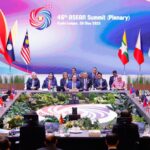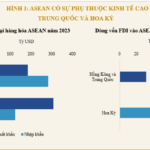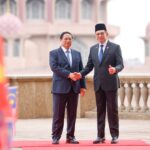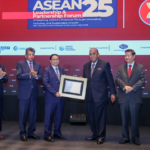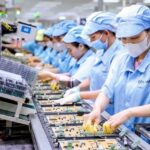Malaysia’s Minister of Investment, Trade and Industry, Tengku Datuk Seri Zafrul Abdul Aziz, emphasized the pivotal role of women in driving ASEAN’s economic prosperity, with a potential contribution of up to $2.3 trillion. Speaking at the 2025 Women’s Economic Summit, held alongside the ASEAN Summit in Kuala Lumpur, Tengku Zafrul highlighted that harnessing the talent of 334 million women in the region through education, opportunity creation, and supportive policies can unlock this immense economic potential.
He also pointed out that women often face multiple barriers to entering and staying in the workforce or starting businesses. To address this, ASEAN needs to create a more conducive environment for women to thrive, enter or re-enter the labor market, start or maintain businesses, without having to choose between their careers and motherhood.
The Minister also shared that at his ministry, women comprise 69% of senior leadership, reflecting Malaysia’s commitment to promoting gender equality. Malaysia’s Madani Economic Framework, focusing on sustainability, prosperity, and inclusivity, places women’s empowerment at the heart of national development.

According to the World Bank, women’s labor force participation rates in some ASEAN countries have reached impressive levels. Illustrative image.
This number is not just a macroeconomic assumption but a reflection of a reality that is already unfolding: when women are given equal opportunities in education, employment, and entrepreneurship, entire communities benefit.
Southeast Asia is Home to One of the Highest Rates of Female Entrepreneurs Globally
Across Southeast Asian nations, women comprise a significant portion of the workforce. According to data from the World Bank, women’s labor force participation rates in some ASEAN countries have reached impressive levels.
They are not just wage earners but also the primary drivers of the informal economy, which contributes significantly to the GDP of many nations. Notably, the entrepreneurial spirit among ASEAN women is thriving. According to a report by Bain & Company and APEC, Southeast Asia is home to one of the highest rates of female entrepreneurs globally.
Women-owned businesses (WSMEs) are creating millions of jobs, driving innovation, and bringing diversity to the business landscape. They operate in various sectors, ranging from retail, food and beverage, and handicrafts to high-tech industries such as fintech and edtech.
These businesses not only generate economic value but also tend to have a more positive social impact, focusing on community development and environmental sustainability. However, the path to economic equality remains challenging. Women in the region still face systemic barriers. The gender wage gap persists. According to the International Labor Organization (ILO), women in Asia-Pacific earn 15-30% less than men on average.
Additionally, women are still underrepresented in senior leadership positions. Despite comprising the majority of the workforce in many industries, the number of women on corporate boards or in CEO roles remains modest. Social biases, the burden of unpaid “care work” like family and child care, along with limited access to capital and business support networks, are significant challenges hindering their potential.
A report by the McKinsey Global Institute (MGI) also indicates that if countries in the region could narrow the gender gap in labor markets, Asia-Pacific’s annual GDP could increase by $4.5 trillion by 2025. The figure of $2.3 trillion for ASEAN alone is a part of this vast potential.
Recognizing this importance, ASEAN governments and regional organizations are increasingly promoting initiatives to support women. Skill-building programs in digital literacy, financial access support, female entrepreneur networks, and policies fostering gender equality in the workplace are being widely implemented.
Which ASEAN Country Fares Best Against US Tariffs?
The negotiations on tariffs with the US are ongoing, and Asian countries, particularly the ASEAN region, are in a hurry to conclude them. As a highly trade-dependent region, ASEAN has much at stake when it comes to US tariff policies. However, resilience lies not in the trade deficit figures but in the intrinsic structure and strategic response capabilities of the region.
Unlocking Trade Potential: Vietnam and Malaysia Aim for $20 Billion Trade Target, Embracing Green Initiatives and Halal Industry
On May 25, during a meeting in Kuala Lumpur, Prime Minister Pham Minh Chinh and his Malaysian counterpart agreed to boost bilateral trade to 20 billion USD by 2030. They also affirmed their commitment to enhancing collaboration in green economy, Halal industry, and defense and security.
“Premier Pham Minh Chinh Named Outstanding ASEAN Leader 2025”
On May 25, in Kuala Lumpur, as part of his official visit to Malaysia and attendance at the 46th ASEAN Summit, Prime Minister Pham Minh Chinh participated in the ASEAN Leadership and Partnership Forum. At this event, the Asia-Pacific Strategic Research Institute (KSI) honored him as the Outstanding ASEAN Leader of the Year 2025 – a recognition of Vietnam’s significant contributions to the region’s development process.
Activating ‘Priority Mode’: A Proposal for Expedited Customs Clearance for High-Tech Goods
“Businesses involved in the manufacturing of integrated circuits, electronic components, and high-tech equipment are now offered a streamlined process for customs clearance. Those who meet the specified criteria will be granted priority status, benefiting from expedited procedures, faster clearance, reduced physical inspections, and pre-arrival customs processing. This efficient system ensures a seamless experience for qualified businesses, enhancing their competitiveness in the dynamic tech industry.”


